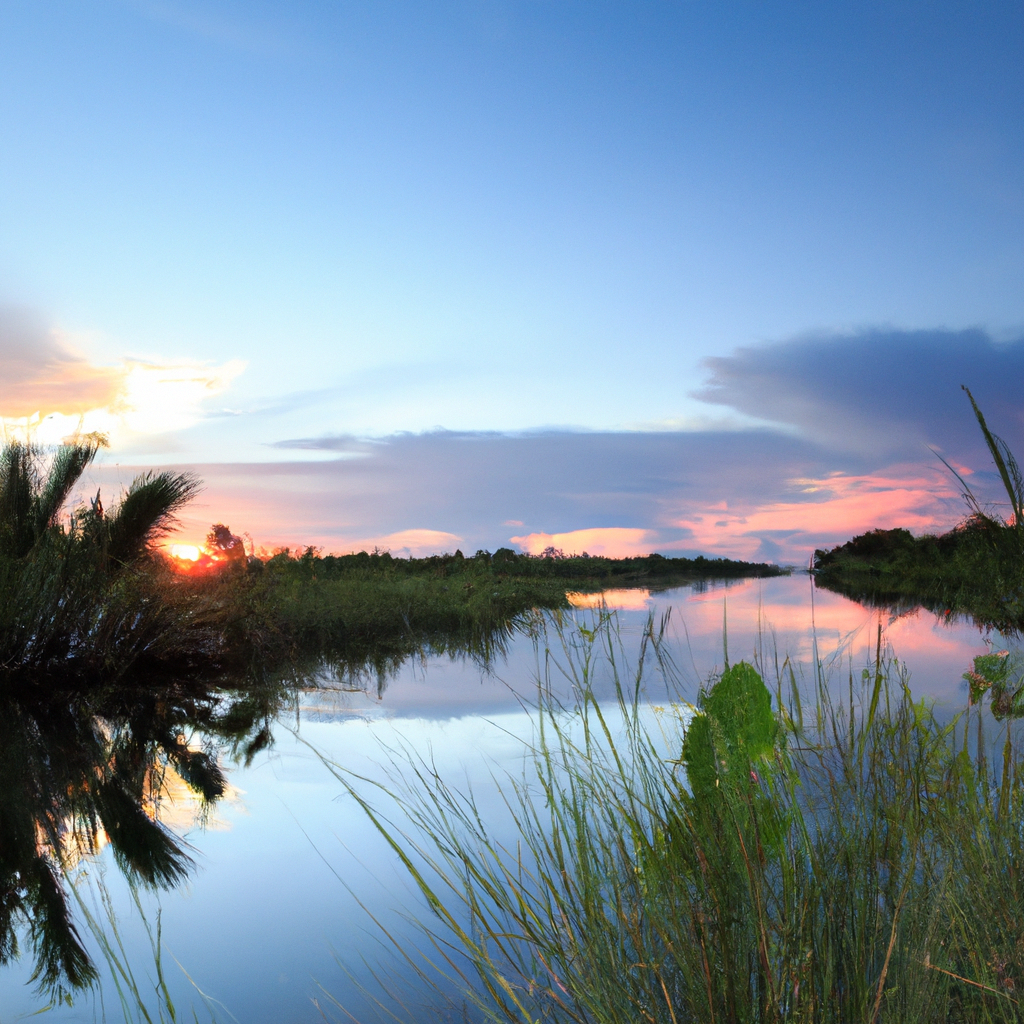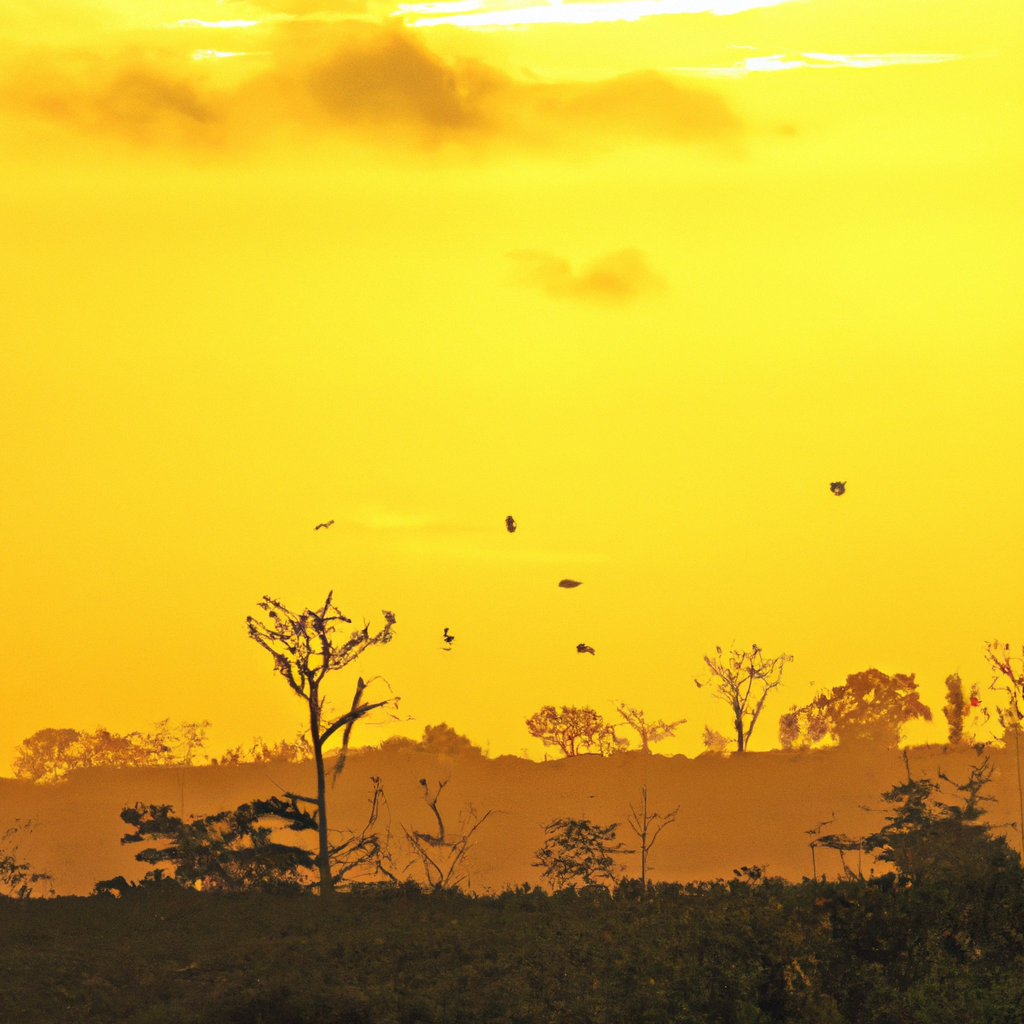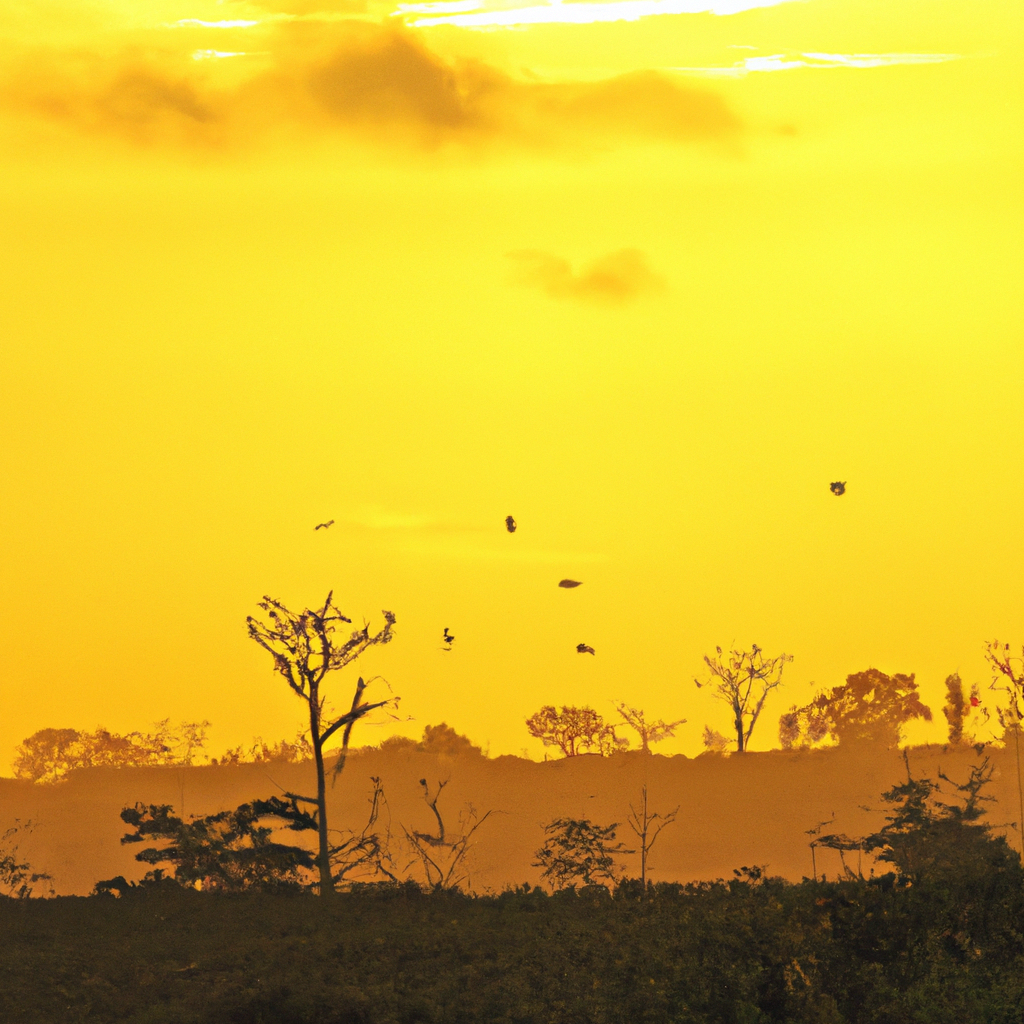Imagine yourself surrounded by lush greenery, serene waterways, and the tranquil sounds of nature. Welcome to the Bigi Pan Nature Reserve, a haven for avid birdwatchers. Located in Suriname, South America, this breathtaking reserve is a paradise for those who appreciate the beauty and diversity of avian species. With its vast wetlands and rich biodiversity, the Bigi Pan Nature Reserve offers a truly immersive experience for bird enthusiasts, providing them with a unique opportunity to observe and photograph countless species in their natural habitat. Whether you’re a seasoned birder or a casual observer, this enchanting reserve promises an unforgettable adventure that will leave you in awe of the mesmerizing world of birds.

Overview
The Bigi Pan Nature Reserve is a hidden gem located on the northern coast of Suriname, just a few hours away from the bustling capital city of Paramaribo. This expansive wetland sanctuary is a haven for birdwatchers and nature enthusiasts, boasting an incredible array of flora and fauna that make it a true paradise for wildlife lovers.
Location
Situated in the Nickerie district, the Bigi Pan Nature Reserve stretches across an impressive 135,000 acres along the coast of Suriname. This coastal wetland is bordered by the Atlantic Ocean to the north and is nestled between the Maratakka and Nickerie Rivers. Its strategic location makes it easily accessible for visitors, offering a peaceful retreat away from the city’s hustle and bustle.
Size and Geography
The Bigi Pan Nature Reserve is a vast wetland, covering an area equivalent to over 53,000 football fields. The reserve consists of a large shallow lagoon, interspersed with numerous islands and mangrove forests. Its diverse landscape supports a thriving ecosystem and offers a wide range of habitats for various species of flora and fauna to flourish.
Flora and Fauna
The Bigi Pan Nature Reserve is home to an impressive variety of plant and animal species, making it a biodiversity hotspot. From colorful bird species to elusive mammals, reptiles, and amphibians, this reserve never fails to captivate nature enthusiasts.
Bird Species
With over 130 recorded bird species, Bigi Pan nature reserve is a birdwatcher’s paradise. The reserve is particularly renowned for its waterfowl, including various species of herons, egrets, and storks. Other notable avian residents include the iconic Scarlet Ibis, the majestic Harpy Eagle, and the vibrant Flamingos. The reserve provides a unique opportunity to observe these magnificent creatures up close in their natural habitat.
Mammals
Although birdwatching takes center stage in Bigi Pan, the reserve also supports a diverse mammal population. Visitors might spot playful monkeys swinging through the trees, elusive jaguars prowling along the shoreline, or manatees gracefully navigating the calm waters. The reserve provides a rare chance to witness these captivating creatures in their natural environment.
Reptiles and Amphibians
Bigi Pan Nature Reserve is also home to a fascinating array of reptiles and amphibians. Visitors might encounter the stealthy caiman lurking in the shallows, graceful turtles basking in the sun, or colorful tree frogs hopping through the mangroves. Exploring the reserve’s marshes and forests offers an opportunity to observe these unique and often misunderstood creatures up close.
Fish
The waters of Bigi Pan teem with life, harboring a rich diversity of fish species. Anglers will delight in the opportunity to hook a prized catch, such as the famed tarpon or the sought-after peacock bass. Whether casting a line from the shore or venturing out onto the tranquil lagoon, fishing enthusiasts are sure to enjoy the thrill of the chase in this aquatic wonderland.
Flora
The Bigi Pan Nature Reserve is adorned with lush vegetation, including an impressive variety of mangrove species. These unique trees have adapted to thrive in brackish waters, forming intricate root systems that provide important habitats for many species of birds, fish, and other wildlife. Exploring the reserve’s mangrove forests offers a glimpse into a thriving ecosystem shaped by the ebb and flow of the tides.
Birdwatching Opportunities
For avid birdwatchers, the Bigi Pan Nature Reserve offers an unparalleled experience, with plenty of opportunities to observe both resident and migratory bird species.
Prime Birdwatching Spots
The reserve is brimming with prime birdwatching spots, each offering a unique vantage point to observe the avian residents. From the conveniently located observation towers to the tranquil boat tours along the lagoon, visitors can immerse themselves in the vibrant birdlife that frequents the reserve. The carefully curated trails and elevated platforms provide optimal viewing opportunities and ensure minimal disturbance to the birds and their habitats.
Popular Bird Species
Birdwatchers will be delighted by the abundance of colorful and unique avian species that call Bigi Pan Nature Reserve their home. The reserve is a sanctuary for numerous waterfowl species, such as the regal Scarlet Ibis, whose vibrant plumage illuminates the wetlands. Other sought-after sightings include the graceful Jabiru, the elegant Agami Heron, and the striking Black-crowned Night Heron. With a little patience and keen observation, visitors are bound to tick off many desired species from their birdwatching checklist.
Migration Season
Bigi Pan Nature Reserve serves as a vital stopover for countless migratory bird species, making it a hotspot for birdwatching during migration season. From September to April, flocks of birds from North and South America gather in the reserve, providing a dazzling spectacle as they navigate their way along ancient migration routes. Witnessing these remarkable journeys is an unforgettable experience and a testament to the importance of preserving the reserve’s fragile ecosystem.
Birdwatching Tips
To make the most of your birdwatching adventure in Bigi Pan Nature Reserve, consider the following tips:
-
Bring binoculars: A good pair of binoculars can make a world of difference in spotting and observing the birds from a distance.
-
Dress for comfort: Wear lightweight, breathable clothing and sturdy footwear to comfortably explore the reserve’s various habitats.
-
Be patient: Birdwatching requires patience and a keen eye. Take your time and be prepared to observe and wait for the birds to reveal themselves.
-
Respect the wildlife: Avoid disturbing the birds and their habitats. Keep noise levels to a minimum and follow all signage and guidelines provided by the reserve.

Activities and Attractions
Beyond birdwatching, the Bigi Pan Nature Reserve offers a range of activities and attractions that cater to different interests.
Boat Tours
Exploring the reserve by boat is a must-do activity for visitors. Boat tours allow you to navigate the labyrinth of waterways and witness the diverse wildlife from a unique perspective. While gliding through the calm waters, you may encounter playful dolphins, curious manatees, and even catch a glimpse of the legendary anaconda. Experienced guides provide fascinating insights into the reserve’s ecology and point out hidden gems along the way.
Fishing
For those who enjoy the thrill of fishing, Bigi Pan Nature Reserve is a paradise. Cast your line and try your luck in the lagoon’s bountiful waters, where prized species such as tarpon, peacock bass, and catfish abound. Whether you are an experienced angler or a beginner, the reserve provides an opportunity to reel in the catch of a lifetime while surrounded by breathtaking natural beauty.
Nature Walks
Embark on guided nature walks and explore the diverse ecosystems that make up Bigi Pan Nature Reserve. Trained guides will lead you through the reserve’s mangrove forests, marshes, and savannas, offering unique insights into the flora and fauna that call this place home. Immerse yourself in the sights, sounds, and scents of the wilderness as you learn about the delicate balance that sustains this biodiverse sanctuary.
Photography
With its stunning landscapes and diverse wildlife, Bigi Pan Nature Reserve offers endless opportunities for photography enthusiasts. From capturing the vivid colors of a Scarlet Ibis in flight to framing the gentle silhouette of a manatee against the setting sun, the reserve provides a playground for creative expression. Whether you are a professional or an amateur photographer, the reserve’s natural beauty is sure to inspire and captivate.
Accommodation and Facilities
To ensure a comfortable and enjoyable stay, the Bigi Pan Nature Reserve offers various accommodation options and on-site facilities to cater to visitors’ needs.
Lodging Options
Visitors can choose from a range of lodging options, including rustic eco-lodges and charming guesthouses. These accommodations provide a comfortable retreat amidst the reserve’s natural splendor, allowing guests to immerse themselves in the serenity of their surroundings. Wake up to the chorus of birdsong and fall asleep beneath a blanket of stars, all while being surrounded by the reserve’s breathtaking landscapes.
Visitor Centers
The reserve is equipped with visitor centers that serve as hubs of information and education. Here, visitors can learn about the reserve’s rich biodiversity through interactive exhibits, guided presentations, and educational programs. Knowledgeable staff are on hand to answer questions, provide assistance, and offer insights into the reserve’s conservation efforts.
Restaurants and Dining
Several on-site restaurants and dining options ensure that visitors can savor the flavors of Suriname while enjoying their stay at Bigi Pan Nature Reserve. From fresh seafood caught in the reserve’s waters to traditional Surinamese delicacies, these eateries offer a range of culinary delights that cater to different tastes and dietary preferences.
Conservation Efforts
Bigi Pan Nature Reserve is not only a haven for wildlife but also a testament to the importance of conservation efforts in preserving delicate ecosystems.
Protected Status
Recognizing the ecological significance of Bigi Pan, the Surinamese government designated it as a Ramsar Wetland of International Importance in 2005. This prestigious status highlights the reserve’s role in providing critical habitats for migratory birds, as well as its cultural and economic value to the region.
Research and Monitoring
Ongoing research and monitoring programs are conducted within the reserve to better understand its unique ecosystems and guide conservation efforts. Scientists and researchers collaborate with local communities and international organizations to study bird populations, track migratory patterns, and assess the health of the reserve’s diverse flora and fauna. These studies play a crucial role in shaping conservation strategies and ensuring the long-term sustainability of the reserve.
Community Involvement
The conservation of Bigi Pan Nature Reserve involves the active participation of local communities. These communities contribute to the protection of the reserve by engaging in sustainable fishing practices, participating in wildlife monitoring programs, and promoting environmental education. By involving local residents in conservation efforts, the reserve strives to create a sense of ownership and foster a sustainable relationship between humans and nature.
Getting There
Traveling to the Bigi Pan Nature Reserve is relatively straightforward, with options to suit every traveler’s preferences.
From Paramaribo
If you’re starting your journey from Paramaribo, the capital city of Suriname, you can reach the reserve by car or public transportation. The drive takes approximately 3 to 4 hours, offering scenic views of the Surinamese countryside along the way. Alternatively, public transportation options such as buses or shared taxis are available, offering a more affordable mode of travel.
By Air
For a quicker and more convenient option, you can fly from Paramaribo to the nearby town of Nickerie. From there, it’s a short drive to the reserve, allowing you to spend more time exploring and less time on the road. Several airlines offer domestic flights to Nickerie, making it a popular choice for those seeking an efficient travel experience.
By Land
For adventurers who prefer the scenic route, traveling by land offers an opportunity to witness the country’s diverse landscapes and soak in the local culture. Suriname’s well-connected road network allows for easy access to the reserve by car or bus. The journey provides a mesmerizing glimpse into the ever-changing scenery, from expansive savannas to picturesque villages nestled along the way.
Local Transportation
Once you arrive at the Bigi Pan Nature Reserve, local transportation options, such as boat tours and guided excursions, are available to navigate the reserve’s waterways and explore its hidden corners. Expert guides and experienced boat operators will ensure a safe and immersive experience, allowing you to fully embrace the tranquility and beauty of this natural wonderland.
Best Time to Visit
To make the most of your visit to the Bigi Pan Nature Reserve, consider the weather and birdwatching seasons.
Weather and Climate
Suriname experiences a tropical climate, with two distinct seasons: a dry season and a wet season. The dry season, which lasts from February to August, generally offers more favorable weather conditions for activities such as birdwatching and hiking. The wet season, from September to January, brings frequent rainfall, creating a lush and vibrant landscape.
Birdwatching Seasons
Birdwatching enthusiasts might prefer to visit during the migratory season, which occurs from September to April. During this time, the reserve attracts a multitude of migratory bird species, resulting in heightened bird activity and an unforgettable birdwatching experience.
Planning and Preparation
To ensure a smooth and enjoyable visit to the Bigi Pan Nature Reserve, it’s essential to plan ahead and make necessary preparations.
Entry Requirements
Before traveling to Suriname, check the visa requirements for your country of residence. Most visitors will require a valid passport and may need to obtain a tourist visa. Additionally, ensure that your travel insurance covers the specific activities you plan to engage in during your visit to the reserve.
Safety Tips
While Bigi Pan Nature Reserve is generally safe to visit, it’s important to take necessary precautions to ensure a hassle-free experience. Be aware of your surroundings and follow the guidance of experienced guides. Keep insect repellent handy, as mosquitoes and other insects are prevalent in tropical environments. Stay hydrated, carry sunscreen, and dress appropriately for the climate and outdoor activities.
What to Pack
To make the most of your visit, consider packing the following essentials:
-
Binoculars: A good pair of binoculars is essential for birdwatching and wildlife observation.
-
Light, breathable clothing: Pack lightweight, breathable clothing suitable for the tropical climate. Opt for long-sleeved shirts and pants to protect against insects.
-
Sturdy footwear: Choose comfortable footwear suitable for walking and exploring various terrains.
-
Sunscreen and insect repellent: Protect your skin from the sun’s rays and insect bites.
-
Waterproof bag or backpack: Keep your belongings protected from the elements during boat tours and outdoor activities.
-
Camera and extra batteries: Capture the incredible wildlife and stunning landscapes with a camera or smartphone.
Conclusion
Visiting the Bigi Pan Nature Reserve is a truly memorable experience for birdwatching enthusiasts and nature lovers alike. This unique sanctuary offers an unrivaled glimpse into the stunning diversity of Suriname’s flora and fauna. From the countless bird species that grace its skies to the tranquil mangroves that line its shores, every corner of this reserve teems with life and invites exploration.
As you immerse yourself in the sights and sounds of Bigi Pan, you can’t help but marvel at the profound beauty and fragile balance of this remarkable ecosystem. The reserve’s protected status, ongoing research efforts, and community involvement are crucial in ensuring the longevity of this unique habitat for future generations to enjoy.
So, pack your bags, grab your binoculars, and immerse yourself in the wonders of the Bigi Pan Nature Reserve—a birdwatcher’s paradise waiting to be discovered.
